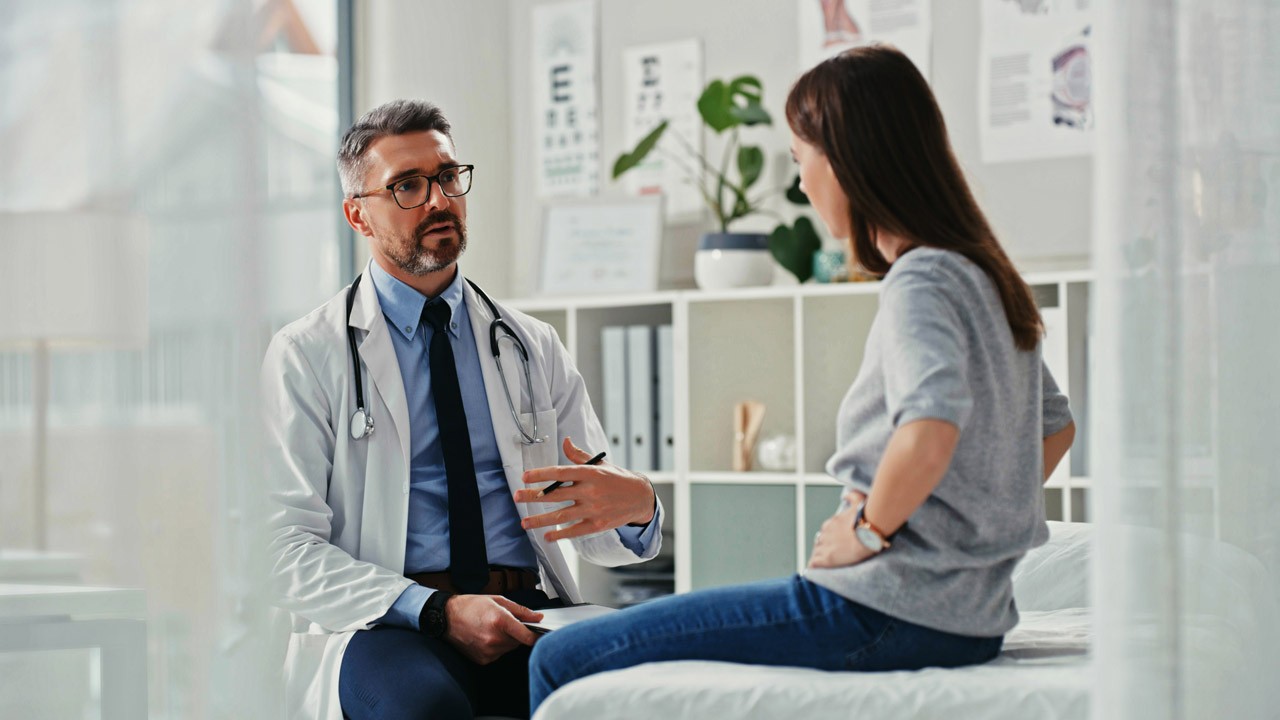Cycle syncing – exercise and diet
Food choices and exercise geared towards your cycle support fitness – and can even help with menstrual cramps and PMS.

Overview of cycle phases
A woman’s menstrual cycle consists of four phases that always follow the same pattern. The follicular phase begins on the first day of a woman’s period. It ends with ovulation. This is followed by the luteal phase, which lasts until menstruation. This is the end of the cycle.
What happens in each phase – simply explained:
-
Menstruation phase
During the menstrual phase, the lining of the uterus is shed along with the unfertilised egg. The period starts, usually lasting 3 to 7 days. The menstrual phase is also the beginning of the follicular phase.
-
Follicular phase
The follicular phase lasts from menstruation to ovulation – usually between 6 and 21 days. This differs from woman to woman and cycle to cycle and can be affected by stress, illness and nutrition.
During this phase, the brain sends the hormone FSH to the ovaries to stimulate 20 to 25 follicles to grow. Each follicle contains one egg cell. As they grow, they produce the hormone oestrogen. The larger the follicles become, the more oestrogen they produce.
At least one egg cell becomes large enough to rupture its follicle and be released. When the oestrogen levels in the blood reach a certain level, the brain is sent the information that the egg is ready. The brain releases the luteinising hormone.
-
Ovulation phase
Ovulation is triggered by the luteinising hormone. The egg cell jumps out of its follicle into the fallopian tube, where it is fertile for between 8 to 18 hours.
If no sperm reaches it during this time, it dissolves. If it is fertilised, it migrates to the uterus within the next 5 to 6 days and implants there. Implantation takes up to 3 more days.
-
Luteal phase
The stage from ovulation to the next period is the luteal phase. It lasts 10 to 16 days. During this phase, the body prepares for the implantation of a fertilised egg. This can last for up to 10 days, because the body doesn’t yet know whether the egg has been fertilised after ovulation, so it prepares itself for everything that a pregnancy needs. If there is no ovulation, the luteal phase is skipped.
The follicle that has burst from the egg constantly produces the hormone progesterone during this phase. Progesterone ensures that no further ovulation takes place. It also increases the body temperature and pulse rate, the mammary glands in the breasts grow and the uterine lining is supplied with more blood. This makes it looser and richer in nutrients.
Once the fertilised egg has implanted in the uterus, it sends the pregnancy hormone hCG to the body. If this signal isn’t received, the body is exhausted at some point and can no longer produce progesterone. Now the hormone levels drop and the body understands that the egg hasn’t been fertilised. The uterine lining, which is heavily supplied with blood, is shed and menstruation begins.
Foods by menstrual cycle
There are lots of questions about nutrition during the menstrual cycle, such as do dietary requirements change at different stages of the menstrual cycle? When should you eat meat? And in which phase of the cycle do you eat more? The cycle phases can be compared with the seasons: The menstrual phase is winter, the follicular phase is spring, the ovulation phase is summer and the luteal phase is autumn.
If you track your cycle, you will see similarities to the seasons in your own cycle. In winter we tend to withdraw, we need peace and quiet and energy levels are low. In spring, our mood rises and our energy increases – this is due to rising hormone levels. In summer we are often full of energy, outgoing and feel particularly attractive. And as autumn approaches and hormone levels drop, we become calmer, more reflective and perhaps more sensitive. Hormones can be brought into balance with a supportive, cycle-based diet.
-
Tips for cycle-based eating
Menstruation phase
As women need more iron in this phase, it is important to choose foods that are high in iron. It’s best to eat iron-rich meals before training, because the body finds it hard to absorb iron straight after physical activity. You should have your iron values checked regularly by a doctor.
And it is important to ensure that you stay hydrated. Magnesium can help against menstrual cramps. If you suffer from cramps, you should pay attention to your magnesium intake in the fourth phase of your cycle.
Foods containing iron (per 100 g):
- Meat (1.8 to 30.5 mg depending on the type)
- Cold cuts (5 to 23.4 mg depending on the type)
- Wheat bran (16 mg)
- Soya beans, dried (9.7 mg)
- Millet (9 mg)
- Lentils (8 mg)
- White beans, dried (7 mg)
- Mushrooms (1 to 6.5 mg depending on the type)
- Chickpeas, dried (6.1 mg)
- Egg yolk (5.5 mg)
- Fish (1.0 to 4.9 mg depending on the type)
Foods containing magnesium (per 100 g):
- Basil, dried (711 mg)
- Pumpkin seeds (530 mg)
- Pure cocoa – instead of chocolate (519 mg)
- Sesame seeds, unhulled (330 mg)
- Sunflower seeds (330 mg)
- Cashew nuts (292 mg)
- Oat bran (240 mg)
- Hazelnuts (160 mg)
- Vegetables such as brussels sprouts and spinach (23 mg, 79 mg)
- Pulses such as soya beans and chickpeas (220 mg, 140 mg)
These foods should be avoided or reduced particularly before and during menstruation:
- Convenience food and junk food: Because they contain a lot of salt, sugar, hydrogenated fats and saturated fatty acids. These can trigger inflammation and exacerbate period pains.
- Sugar and white flour: These products both cause blood sugar levels to fluctuate and trigger the next cravings.
- Caffeine: Caffeine in drinks and food can constrict blood vessels, increase blood pressure and increase menstrual cramps. It can also inhibit iron absorption.
- Alcohol: Alcohol consumption can increase PMS symptoms and change the length of the cycle by affecting hormone levels.
- Salt: Too much salt can promote water retention.
- Animal products: Eating meat and meat products can increase menstrual cramps and contain hormones that affect the body and the menstrual cycle.
Follicular phase
Some women have less of an appetite during this phase and may run up a calorie deficit. Therefore, it is important to adjust what you eat to how much sport you’re doing to ensure that you have a balanced calorie intake.
Foods that give athletes a lot of energy:
- Edamame
- Lean red meat
- Beans
- Pulses
- Dried fruit
Ovulation phase
During the ovulation phase, the increase in oestrogen stimulates the production of luteinising hormone (LH), which leads to ovulation. Oestrogen is produced in the ovaries and has various functions in the body, including building strong bones, good blood circulation and better functioning of the nervous system. Oestrogen also acts like an antidepressant by boosting the effect of the happiness hormone serotonin.
Foods that promote the production of oestrogen:
- Soya
- Celery
- Cucumber
- Liquorice
- Fenugreek
- Pomegranates
- Hops (as tea)
- Linseeds
- Pulses
- Yeast
- Fennel
- Peanuts
- Olives
- Herbs such as nettles, verbena, lemon balm, rosemary and sage
- Spices such as aniseed, basil, dill, ginger, coriander and elderflower
Luteal phase
A rise in progesterone impacts your muscle-building capacity, and your performance levels may fall. Therefore, as progesterone tends to break down protein faster, you should add a little more protein to your diet at this time.
Foods containing protein (per 100 g):
- Soya beans (34 g)
- Pumpkin seeds (24.4 mg)
- Linseeds (24.4 g)
- Chicken breast (24 g)
- Pine nuts (24 g)
- Lentils (23.5 mg)
- Sunflower seeds (22.6 mg)
- Tuna (22 g)
- White beans (21 g)
- Almonds (19 g)
- Sesame (18 g)
- Feta (17 g)
- Walnuts (14 g)
- Low-fat quark (14 g)
- Eggs (13 g)
- Cottage cheese (13 g)
- Quinoa (12 g)
- Tofu (11 g)
-
Seed cycling
Seed cycling is a growing trend claimed to balance hormones, boost fertility and ease symptoms of menopause.
It involves eating flax, pumpkin, sesame and sunflower seeds at different times of the month to balance certain hormones. Seeds and grains contain certain oils, vitamins and nutrients which have a positive impact on hormone production and regulation in the body.
Seeds, their properties and the appropriate cycle phase:
- Ground flax and pumpkin seeds in the follicular phase: During the follicular phase, which begins on the first day of menstruation, take 1 to 2 tablespoons of linseed and pumpkin seeds daily. It is best to use ground linseed so that the body can absorb and utilise the omega-3 fatty acids it contains.
Linseed and pumpkin seeds are rich in lignans, which can help increase or decrease oestrogen levels as needed. In other words, plant-based substances that are similar to natural oestrogen. They support the production of oestrogen in the body. - Sesame and sunflower seeds in the luteal phase: During ovulation and at the start of the luteal phase, seed cyclers switch to 1 to 2 tablespoons each of sunflower and sesame seeds per day. Sesame seeds also contain lignans, while sunflower seeds are rich in important nutrients that help support hormonal balance during the luteal phase.
Sesame also has valuable anti-inflammatory properties, which is important because inflammation affects the hormonal balance. Sesame also promotes cholesterol metabolism. This is particularly important for hormone regulation, because sex hormones are formed from cholesterol.
The seeds can be eaten as they are or added to smoothies, muesli or salads. Taking 1 to 2 tablespoons a day is said to alleviate hormonal symptoms. Although there’s no scientific evidence of the effectiveness of seed cycling, many women swear by it. And as seeds are generally healthy, it’s worth a try.
- Ground flax and pumpkin seeds in the follicular phase: During the follicular phase, which begins on the first day of menstruation, take 1 to 2 tablespoons of linseed and pumpkin seeds daily. It is best to use ground linseed so that the body can absorb and utilise the omega-3 fatty acids it contains.
-
Cravings before your period?
Foods that keep you fuller for longer are important to prevent cravings. Wholegrain products, avocado or chicken help keep blood sugar levels stable. Foods rich in antioxidants, such as fruit, vegetables and pulses, as well as anti-inflammatory foods, such as salmon and walnuts, can help ease PMS symptoms.
Dark chocolate − enjoyed in moderation − contains many healthy polyphenols and, thanks to its high stearic acid content, has a positive effect on lipid metabolism.
Anyone who has problems sleeping should try drinking melatonin-rich milk in the evening. Other sleep-enhancing foods include sour cherries and tryptophan-rich foods such as eggs, fish, pumpkin seeds and peanuts.
“Miracles do not happen: In terms of performance, training in line with your cycle adds that little bit extra.”
Training in line with the menstrual cycle
Women can base their training on their menstrual cycle. This helps in particular to improve their well-being during the different phases. There is currently insufficient scientific evidence that cyclical hormonal changes affect performance or longer-term adaptations to strength training. "Miracles don't happen: In terms of performance, training in line with your cycle adds that little bit extra. If you want to improve, you first have to optimise all other known factors,” says Dr Nora Wieloch, Head of the Women and Sport department at the University Centre for Prevention and Sports Medicine at Balgrist University Hospital.
-
Influence of hormones
The hormones oestrogen and progesterone, which are produced in the ovaries, play a particularly important role in the female cycle. “Put simply, oestrogen levels rise in the first half of the cycle. This hormone tends to build muscle mass and promote the storage of fat in muscle,” explains Wieloch.
It also increases free fatty acid availability during sporting activity. Oestrogen helps build strong bones and counteracts bone ageing. It also helps keep ligaments and tendons supple.
Progesterone dominates in the second half of the cycle, causing the body temperature to rise slightly. There is evidence that it promotes the breakdown of protein stores and maybe even of muscle mass. However, further studies are needed to be able to provide generally applicable recommendations for training based on the menstrual cycle.
Anyone interested could take a look at the existing recommendations for competitive sport, such as those published by Swiss Olympic.
It is also important to note that basing training on your menstrual cycle doesn’t work if you’re taking hormonal contraceptives, such as the pill, because your hormonal levels remain pretty stable in this case.
-
How to train in line with your cycle
It is important to be aware of the different phases of your cycle and know what effect they have.
At the start of a new cycle, many women feel off-colour and heavy and find it hard to concentrate. However, some women regain their interest in exercise as soon as their period starts. There is evidence that exercising regularly, about three times a week for 45 to 60 minutes at a time, can help relieve menstrual pain.
Follicular phase
Most women feel great in this phase. Energy levels and concentration improve. Many women report that they can push themselves a bit harder during training in this phase.
But experts warn that you shouldn’t ramp up your training too much. And remember that warming up, cooling down and taking enough recovery time are just as important as the training itself. There is currently insufficient scientific data to make clear training recommendations based on the cycle phase.
Ovulation phase
This is the shortest of the four phases. Some women experience ovulation as a brief pain or a pulling sensation in the abdomen. Energy and endurance levels during ovulation are likely to be close to those of the follicular phase as you’ll still be experiencing elevated levels of oestrogen.
Luteal phase
“In this phase, women tend to report a slight fall in their performance,” says Wieloch. Body temperature, resting heart rate and respiratory rate increase. And your body finds it harder to regulate changes in temperature. So it’s very important to ensure you are properly hydrated, particularly during long endurance sessions.
A rise in progesterone impacts your muscle-building capacity, and your performance levels may fall. The decreasing hormone levels towards the end of the luteal phase often give rise to mood swings and fluctuations in energy levels.
In this premenstrual phase, energy levels may fall, and women may be less inclined to exercise. Getting plenty of sleep can help. Putting yourself under pressure to train may actually worsen your PMS symptoms. You should therefore focus on recovery at this point in your cycle.
However, you don’t need to stop exercising completely. If you suffer from PMS, you will maybe benefit from light exercise such as yoga. Remember that sport has an anti-inflammatory effect and releases endorphins – and this can even improve your mood.
“In this phase, women tend to report a slight fall in their performance.”
Top training tips from Dr Nora Wieloch
“In sports medicine, we always recommend using personal training plans. The menstrual cycle affects women differently, so it’s crucial that we learn to listen to our bodies.” It’s best to track when you feel fatigued or motivated, irritable or happy, hungry or lacking in appetite. Many apps are available on the market today to help you do this. You can learn a lot about your menstrual cycle from this data.
If you have severe menstrual pain, it is important to be kind to your body and not to put yourself under pressure. But further studies are needed to be able to make specific recommendations.
A regular menstrual cycle is a reliable indicator that your body is basically doing OK. So it’s best to accept − and maybe utilise − the phases of your cycle based on your own experiences. If you often miss periods, it’s a good idea to see a doctor.
Bonus tip: track your cycle
With all the recommendations for diet and training, don’t forget that all women are different and have individual requirements and needs. The tips from Dr Nora Wieloch confirm that it’s hugely important to observe the menstrual cycle. A period and cycle tracker app can help.
It’s also a good idea to keep a cycle diary. Briefly note down the day of the cycle every day and what you notice about your body. Other useful questions while observing your cycle:
- How long does your period last?
- How heavy is your period?
- Appearance of the menstrual blood?
- When do you have bleeding between periods?
- How do you feel physically today?
- How do you feel mentally today?
- What changes do you notice in your body?
- How are your energy levels?
- Are you stressed?
- Do you have cravings for food?
- What have you eaten and drunk?
- How do you feel?
- Have you exercised today?
- Have you taken time for yourself today? What did you do?

Dr Nora Wieloch is Deputy Head of the University Centre for Prevention and Sports Medicine at Balgrist University Hospital. She also looks after the gymnasts in the Swiss Gymnastics Federation, the women’s football team of Grasshoppers Club Zurich and is team doctor for the Winter World University Games.
She is also a member of Sport & Exercise Medicine Switzerland (SEMS), the Swiss Sports Nutrition Society (SSNS) and other prestigious associations.




